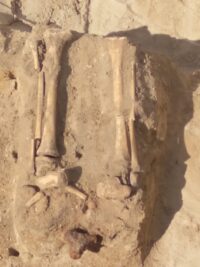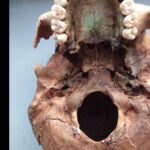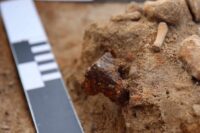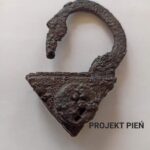 The remains of a young child buried face down with a triangular padlock under the left foot have been discovered in the same cemetery in Pień, northern Poland, where the woman buried with a sickle over her neck and a padlock on her toe was found last year. The child’s grave is just five feet away from the woman’s.
The remains of a young child buried face down with a triangular padlock under the left foot have been discovered in the same cemetery in Pień, northern Poland, where the woman buried with a sickle over her neck and a padlock on her toe was found last year. The child’s grave is just five feet away from the woman’s.
A triangular padlock was found first loose in the topsoil. The subsequent excavation of the area revealed the grave of a child around 5-7 years old at time of death. The child had been buried face-down as an anti-revenant ritual that would compel the deceased to “bite into the ground,” and make it impossible for him to rise from the grave to harm the living.
Another padlock was found under his left heel, likely shifted to this location with the decomposition of the soft tissues. It would originally have been locked to his toe. This too was a ritual meant to bind him to the grave and prevent his return from the dead. Unusually, the grave was later desecrated and all the bones removed except the legs. The arrangement of the leg bones is how we know the child was buried with his face in the ground.

 It’s possible the bones were scattered near the child’s grave. The skeletal remains of three children were found in a pit nearby, and among them was a jaw fragment with a green stain. The woman buried with the sickle over her neck also had a green stain on her palate. The green in the jaw fragment from the child is likely to have been left by a copper coin. Tests of the composition of the stain on the woman’s palate found it contain trace amounts of gold, potassium permanganate and copper, suggesting it was something else entirely, perhaps a treatment for whatever was ailing her.
It’s possible the bones were scattered near the child’s grave. The skeletal remains of three children were found in a pit nearby, and among them was a jaw fragment with a green stain. The woman buried with the sickle over her neck also had a green stain on her palate. The green in the jaw fragment from the child is likely to have been left by a copper coin. Tests of the composition of the stain on the woman’s palate found it contain trace amounts of gold, potassium permanganate and copper, suggesting it was something else entirely, perhaps a treatment for whatever was ailing her.
These types of burials are colloquially referred to as vampire burials, but they have no connection to the vampire legends as we know them today. The folk beliefs that led to deviant burials long predate the bloodsucker-bat legends. At the core of them all is the idea that the person who died differed dangerously from the norm, either in life — their looks, speech, behavior — or in the nature of their illness. Whatever the reason, they were considered flight risks, as it were, from the grave, and ritual precautions were taken to ensure they stayed put.
 The woman with the sickle on her neck and the padlocked child were not the only deviant burials found in the Pień cemetery. In the northern section of the cemetery archaeologists unearthed the grave of a pregnant woman who died in the 24th week of her pregnancy. The fetal bones have survived, which is unusual because they are tiny and very prone to decomposition. A large number of stones, some big enough to be considered small boulders, were in the backfill of the grave pit. Such stones have been found deliberately placed in other graves on the neck, chest and by the skull of the dead. Fragments of ceramic vessels were found placed near the heads of two people in nearby graves, and the bottom of the ceramic vessel was found on the foot of an individual buried in another grave.
The woman with the sickle on her neck and the padlocked child were not the only deviant burials found in the Pień cemetery. In the northern section of the cemetery archaeologists unearthed the grave of a pregnant woman who died in the 24th week of her pregnancy. The fetal bones have survived, which is unusual because they are tiny and very prone to decomposition. A large number of stones, some big enough to be considered small boulders, were in the backfill of the grave pit. Such stones have been found deliberately placed in other graves on the neck, chest and by the skull of the dead. Fragments of ceramic vessels were found placed near the heads of two people in nearby graves, and the bottom of the ceramic vessel was found on the foot of an individual buried in another grave.
 Archaeologists believe that the cemetery was a dedicated burial ground for people excluded by society. It was not attached to a church and there is no evidence on the historical record that the cemetery was even consecrated ground. These were likely extra-legal burials.
Archaeologists believe that the cemetery was a dedicated burial ground for people excluded by society. It was not attached to a church and there is no evidence on the historical record that the cemetery was even consecrated ground. These were likely extra-legal burials.
Samples have been taken from the skeletal remains for DNA and stable isotope analyses. These tests may answer questions about the people buried in the cemetery, their health, their appearance, whether they were local or immigrants, whether any of them are related to each other, etc.
* This article was originally published here











No comments:
Post a Comment